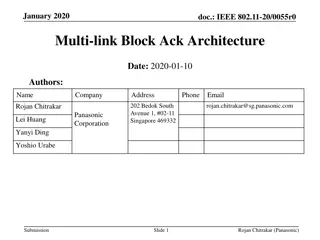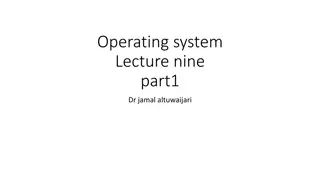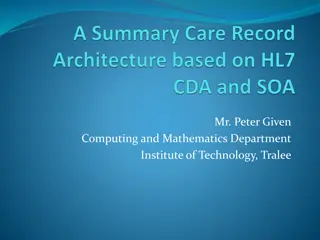Contiguous UL CA Architecture Overview
This document discusses the architecture and capabilities of intra-band contiguous UL carrier aggregation, focusing on issues related to multiple transmit chains, MIMO support, and potential MPR improvements. It also covers topics like ACLR MBW position, inner and outer contiguous allocation definitions, and proposed shifts for addressing signaling needs. The discussions revolve around baseline architecture for Rel16 and considerations for future releases, offering a detailed examination of the technical aspects involved.
Download Presentation

Please find below an Image/Link to download the presentation.
The content on the website is provided AS IS for your information and personal use only. It may not be sold, licensed, or shared on other websites without obtaining consent from the author. Download presentation by click this link. If you encounter any issues during the download, it is possible that the publisher has removed the file from their server.
E N D
Presentation Transcript
3GPP TSG-RAN WG4 Meeting #95-e Electronic Meeting, May 25th June 5th2020 R4-2008466 WF on intra-band contiguous UL CA MPR and A-MPR remaining issues Skyworks, Nokia, [Huawei, HiSilicon], [Qualcomm]
WF on contiguous UL CA architecture and capabilities Baseline architecture for Rel16 use one transmit chain for both BW class B and C UL CA 1TX chain is the default assumption (ie assumed if not signaling of architecture) if UL MIMO is supported in single CC mode it is supported in CA mode a single DC location is declared 2PA architecture is not precluded for BW class C 2TX chain signaling is needed to cover: Declaration of two DC location instead of one UL MIMO support or not Potential MPR improvements in future releases
WF on ACLR MBW position Agreed measurement bandwidth in last meeting: ???????_??= SUM?(??????? ? ?????_????????) +???????,??? +???????, ?? 2 2 Proposed shift in [1]: Difference between of ACLR MBW center and BWChannel_CA center is: ???????,??? ???????, ?? 2 where MBWACLR,low and MBWACLR,high are the single-channel ACLR MBWs for channel bandwidths BWChannel(low)and BWChannel(high), respectively, as specified in TS 38-101-1, Table 6.5.2.4.1-1. However, the center of aggregated channels corresponds to nothing concrete and may not correspond to TXLO in most of the cases +???????, ?? ???????,??? ???????,? ???= 4 Proposed Way Forward: For unambiguous position and validity for multiple CC the ACLR MBW shift is thus reffered to the first CC carrier FC,low : ???????,? ???= (???????_??+ ???????,???)/2
Background on Inner and outer contiguous allocation definitions Inner allocation reuses the same concept than single CC allocation of inner half allocation but applied to the 15kHz SCS equivalent aggregated contiguous allocation
WF on Inner and outer contiguous allocation definitions Contiguous allocation definition(lower channel is CC1): RBStart1 + LCRB1= NRB1, andRBStart2 = 0 In contiguous CA, a contiguous allocation is an inner allocation if RBStart,Low RBStart_CA RBStart,High,and NRB_alloc ceil(NRB,agg/2), where RBStart,Low= max(1, floor(NRB_alloc/2)) , RBStart,High= NRB,agg RBStart,Low NRB,alloc, with NRB_alloc= (NRB1- RBStart1) 2^ 1+ (RBStart2+ LCRB2) 2^ 2, NRB,agg=NRB1 2^ 1+ NRB2 2^ 2. If LCRB1 =0, RBStart_CA= NRB1 2^ 1+ RBStart2 2^ 2, else, RBStart_CA= RBStart1 2^ 1. A contiguous allocation that is not an Inner contiguous allocation is an Outer contiguous allocation
Background on Inner and outer contiguous allocation MPR for Class B and C Modulation CA bandwidth Class B and C / Smallest Component Carrier Transmission Bandwidth Configuration 25 RB 50 RB > 8 and 25 > 12 and 50 > 25 > 50 8 12 > 8 and 25 > 12 and 50 > 25 > 50 8 and allocation wholly contained within a single CC within a single CC > 8 or allocation extends across two CC's CC's 1 MPR (dB) MPR for bandwidth class B [dB] inner Avg TBD 0 [0-1.5] 1 [1-2] 1.5 [2.5-4] 3 [6-6.5] 5.5 [1.5-2] 2 [2-2.5] 2.5 [3.5-4] 3.5 [6-6.5] 6.5 MPR for bandwidth class C [dB] inner Avg TBD na 2.5 2.5 2.5 2.5 5 5 [6.5-7] 7 [3-3.5] 3.5 3.5 3.5 5 5 [6.5-7] 7 Modulation outer TBD [2-4] [3-4] [3.5-4] [6-6.5] [3-5.5] [3-4] [3.5-4] [6-6.5] Avg 1.5 3.5 3.5 4 6 4.5 3.5 4 6.5 outer TBD [5-8] [6-8] [6-8] [6.5-8] [6-8] [6-8] [6-8] [6.5-8] Avg 6 6.5 7 7 7.5 7 7 7 7.5 75 RB 100 RB Pi/2 BPSK QPSK 16QAM 64QAM 256QAM QPSK 16QAM 64QAM 256QAM QPSK QPSK 16 QAM 16 QAM 16 QAM 64 QAM > 16 and 75 > 75 16 > 16 and 75 > 75 16 and allocation wholly contained within a single CC > 16 or allocation extends across two CC's > 18 and 100 > 100 18 > 18 and 100 > 100 18 and allocation wholly contained within a single CC > 18 or allocation extends across two CC's 1 2 1 2 3 2 DFT-s- OFDM 12 and allocation wholly contained CP- OFDM 64 QAM > 12 or allocation extends across two 3 256 QAM 5 Left table is based on [4,5,6] with 3 company inputs for QPSK, two companies for 16/64/256QAM and only one company for Pi/2 BPSK, For comparison LTE table is provided on the right NR class B DFT-s-OFDM Outer is at least 1.5dB higher MPR than worst case LTE class C Outer for CP-OFDM QPSK is inconsistent Some companies show a significant difference (>3dB) between class B and class C for outer allocations while inner allocations have a smaller offset Two PA implementations for class C should have lower MPR as shown in [4]
WF on Inner and outer contiguous allocation MPR for Class B and C MPR for bandwidth class B [dB] inner 1.0 1.0 1.5 3.0 5.5 2.0 2.5 3.5 6.5 MPR for bandwidth class C [dB] inner 2.5 2.5 2.5 5 7 3.5 3.5 5 7 Modulation outer 3.5 3.5 3.5 4.0 6.0 4.0 4.0 4.0 6.5 outer 7 7 7 7 7.5 8 8 8 8 Pi/2 BPSK QPSK 16QAM 64QAM 256QAM QPSK 16QAM 64QAM 256QAM DFT-s-OFDM CP-OFDM This table is applicable to 1PA architecture for BW class B 1PA and 2PA architecture for BW class C in Release 16, Improved BW class C MPR for 2PA is FFS in future release Pi/2 BPSK data is extrapolated from QPSK assuming same ACLR limitation
Background on Inner, outer1 and outer2 non- contiguous allocation definitions Non-contiguous allocation MPR is driven by the location of the allocation in with regard to the SEM mask Inner allocations are such that IMD3 fall within BW_CA of the wanted signal and thus IMD5 falls within BW_CA adjacent to the wanted signal => IMD5 needs to meet -13dBm/MHz Required BW between allocation and channel CA edge (Inner) Required BW between allocation and channel CA edge (Inner) Lowest allocation position Lower guard BWGB,low Upper guard BWGB,high This illustrates the Inner RBstart,low and high concepts and other parameters used in the allocation definition in following pages Minimum unallocated RBStart,Low 0.18MHz Allocation & gap NRB_alloc 0.18MHz + BWgap Unallocated BWChannel_CA Lower guard BWGB,low Upper guard BWGB,high Maximum unallocated RBStart,High 0.18MHz Allocation & gap NRB_alloc 0.18MHz + BWgap Unallocated Required BW between allocation and channel CA edge (Inner) Required BW between allocation and channel CA edge (Inner) Highest allocation position Outer1 allocations are such that IMD3 and IMD5 falls within BW_CA adjacent to the wanted signal => IMD3 needs to meet -13dBm/MHz Outer2 allocations are such that IMD3 falls within BW_CA adjacent to the wanted signal and IMD5 falls within BW_CA second-adjacent to the wanted signal => IMD5 needs to meet - 30dBm/MHz
WF on non-contiguous allocation definitions: Inner allocation Non-contiguous allocation definition: RBStart1 + LCRB1< NRB1, orRBStart2 > 0 In contiguous CA, a non-contiguous RB allocation is a non-contiguous Inner RB allocation if the following conditions are met: RBStart,Low RBStart_CA RBStart,Highand NRB_alloc ceil((BWChannel_CA/ 3 BWgap) / 0.18MHz), where NRB_alloc= (NRB1- RBStart1) 2^ 1+ (RBStart2+ LCRB2) 2^ 2, RBStart_CA= RBStart1 2^ 1 RBStart,Low= max(1, floor(NRB_alloc+ (BWgap BWGB,low)/0.18MHz)) RBStart,High= floor((BWChannel_CA 2 BWgap BWGB,low)/0.18MHz 2 NRB_alloc) BWGB,low=Foffset,low (NRB1 12+1) SCS1/2 BWgapis the bandwidth of the gap between NRB1and NRB2possible allocations of CC1 and CC2 respectively.
WF on non-contiguous allocation definitions: Outer1 and Outer 2 allocations In contiguous CA, a non-contiguous RB allocation is a non-contiguous outer 1 RB allocation if the following conditions are met: RBStart,Low RBStart_CA RBStart,Highand NRB_alloc ceil((3 BWChannel_CA/ 5 BWgap) / 0.18MHz) where RBStart,Low= max(1, 2 NRB_alloc floor( (BWChannel_CA 2 BWgap+ BWGB,low)/0.18MHz)), RBStart,High= floor((2 BWChannel_CA 3 BWgap BWGB,low) / 0.18MHz 3 NRB_alloc) NRB_alloc , RBStart_CA , BWgapand BWGB,loware as defined for the Inner region. In contiguous CA, a non-contiguous allocation is an Outer 2 allocation if it is neither an non-contiguous Inner allocation nor an Outer 1 allocation.
Background on Inner and outer non-contiguous allocation MPR for Class B and C Below table is based on 3 company inputs For UE power class 3 intra-band contiguous carrier aggregation bandwidth class C with non-contiguous resource allocation, the allowed Maximum Power Reduction (MPR) for the maximum output power in Table 6.2.2A-1 is specified as follows MPR = CEIL { min(MA, MIM5),0.5} Where MA is defined as follows for QPSK, 16 QAM and 64 QAM MA= 8.2; 0 A < 0.025 9.2 - 40A ; 0.025 A < 0.05 8 16A; 0.05 A < 0.25 4.83 3.33A ; 0.25 A 0.4, 3.83 0.83A; 0.4 A 1, and MIM5 is defined as follows MIM5= 4.5 ; IM5< 1.5 * BWChannel_CA 6.0; 1.5 * BWChannel_CA IM5< BWChannel_CA/2 + FOOB MA; IM5 BWChannel_CA/2 + FOOB MPR for bandwidth class B [dB] MPR for bandwidth class C [dB] Modulation inner Avg Outer1 Avg Outer2 Avg inner Avg Outer1 Avg Outer2 Avg Pi/2 BPSK QPSK 16QAM 64QAM 256QAM QPSK 16QAM 64QAM 256QAM TBD [0-3] [1-4] [2.5-6] [6.5-7] [1.5-4] [2-4] [3.5-6] [6.5-8] 2 2 TBD [4.5-6] [4.5-6] [4.5-6] [6.5-7] [5.5-8] [5.5-8] [5.5-8] [6.5-8] 5.5 5.5 5.5 6 6.5 6.5 7 7 7.5 TBD TBD [0-5] [1-5] [2.5-7] [6.5-8] [1.5-5] [2-5] [3.5-6] [6.5-8] 2.5 2.5 3 5 6.5 3.5 3.5 5 7.5 TBD [4.5-7] [4.5-7] [4.5-7] [6.5-8] [5.5-8] [5.5-8] [5.5-8] [6.5-8] 6 6 6 6 TBD DFT-s- OFDM 2.5 4.5 6 2.5 3 5 7.5 6.5 7 7 7 7.5 [9-13] 10.5 [9.5-14] 11.5 CP- OFDM Left table is based on [4,5,6] with 3 company inputs for QPSK, two companies for 16/64/256QAM and only one company for Pi/2 BPSK, For comparison LTE equation is provided on the right NR class B DFT-s-OFDM Outer2 is at least 2dB higher MPR than worst case LTE class C Two companies propose that outer1 and outer 2 have MPR dependant on aggregated allocation bandwidth since MPR is dominated by 1RB+1RB IMDs failing SEM, more conservative MPR is acceptable if MPR is reduced at larger BW Two PA implementations for class C should have lower MPR as shown in [4]
WF on Inner and outer non-contiguous allocation MPR for Class B and C MPR for bandwidth class B [dB] Inner Outer11 2 5.5 2 5.5 2.5 5.5 4.5 6 6 6.5 2.5 6.5 3 7 5 7 7.5 7.5 MPR for bandwidth class C [dB] Outer11 6 6 6 6 6.5 7 7 7 7.5 Modulation Outer22 Outer22 Inner 2.5 2.5 3 5 6.5 3.5 3.5 5 7.5 Pi/2 BPSK QPSK 16QAM 64QAM 256QAM QPSK 16QAM 64QAM 256QAM DFT-s-OFDM 11.5 13 CP-OFDM 12 14 NOTE 1: Outer 1 MPR is reduced by 3dB for aggregated allocation bandwidth > 10MHz NOTE 2: Outer 2 MPR is reduced by 4.5dB for aggregated allocation bandwidth > 10MHz This table is applicable to 1PA architecture for BW class B 1PA and 2PA architecture for BW class C in Release 16, Improved BW class C MPR for 2PA is FFS in future release Pi/2 BPSK data is extrapolated from QPSK assuming same ACLR limitation
Background on AMPR for NS04 and NS27 NS-04 and NS27 -13dBm/MHz OOB requirement is such that: It is covered by contiguous Inner and outer allocations MPR automatically since they meets -13dBm/MHz It is covered by non-contiguous Inner and outer1 allocations MPR automatically since IMD3 and IMD5 meets -13dBm/MHz NS-04 -25dBm/MHz OOB requirement is such that: It is covered by non-contiguous outer2 allocations MPR when IMD3 falls within the - 13dBm/MHz OOB region (IMD5 meets -30dBm/MHz then) NS-27 -40dBm/MHz OOB requirement is such that: All MPR cannot cover for IM3/5 falling in -40dBm/MHz region Only outer2 non-contiguous allocation MPR may cover for IMD7 falling in - 40dBm/MHz region
WF on AMPR for NS04 and NS27 A-MPR for NS-04 and NS27 -13dBm/MHz OOB requirement is studied for channel and allocation positions when outer2 non contiguous allocation fall in this region A-MPR for NS-04 -25dBm/MHz OOB requirement is studied for channel and allocation positions when: Contiguous outer IMD3 spectrum overlaps with this region Non-contiguous outer1 IMD3 spectrum overlaps with this region A-MPR for NS-27 -40dBm/MHz OOB requirement is studied for channel and allocation positions when: Contiguous inner and outer IMD3 spectrum overlaps with this region Non-contiguous allocation IM3/5/7 fall in this region
References in this meeting References on Bandwidth definitions [1] R4-2008010 ACLR measurement center frequency for NR FR1 contiguous CA, Nokia, Nokia Shanghai Bell [2] R4-2008202 Intra-band Contiguous ULCA MBW and ACLR Offset, Qualcomm Incorporated [3] R4-2008255 [NR FR1 ULCA] Class B and C Bandwidth Verification, Skyworks Solutions Inc. References on MPR and A-MPR [4] R4-2008207 Intra-band Contiguous ULCA MPR, Qualcomm Incorporated [5] R4-2008148 on FR1 UL CA MPR requirement Rel-16, Huawei, HiSilicon [6] R4-2006638 [NR FR1 ULCA] Class B and C UL CA MPR Proposals and A-MPR Evaluation, Skyworks Solutions Inc. References on Allocation definition [7] R4-2006637 [NR FR1 ULCA] Contiguous Intra-band ULCA Allocation Definitions, Skyworks Solutions Inc.























